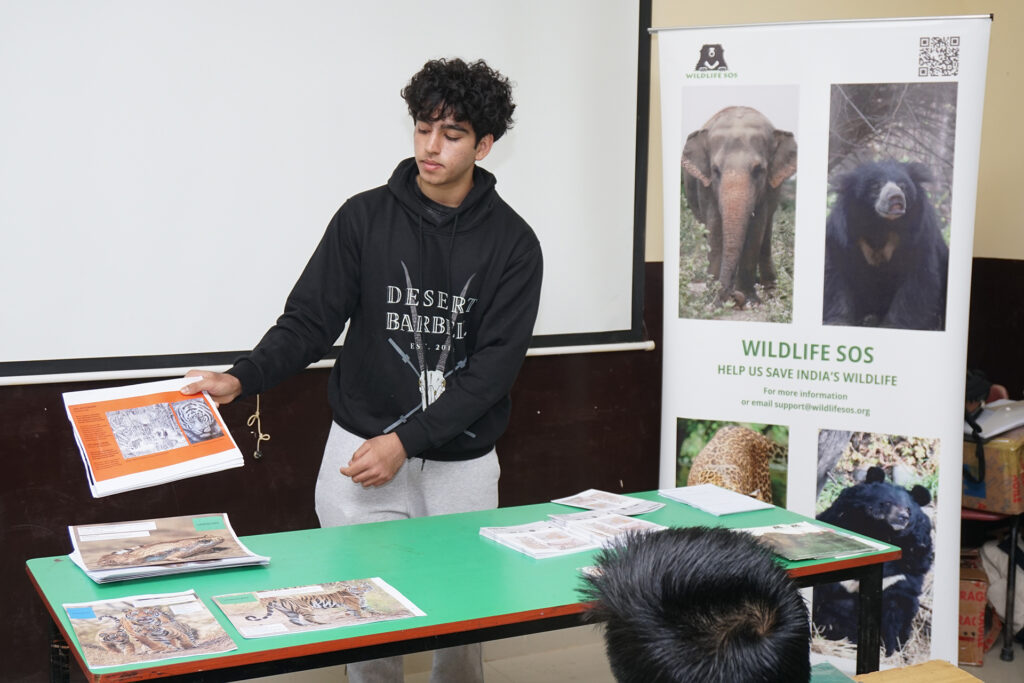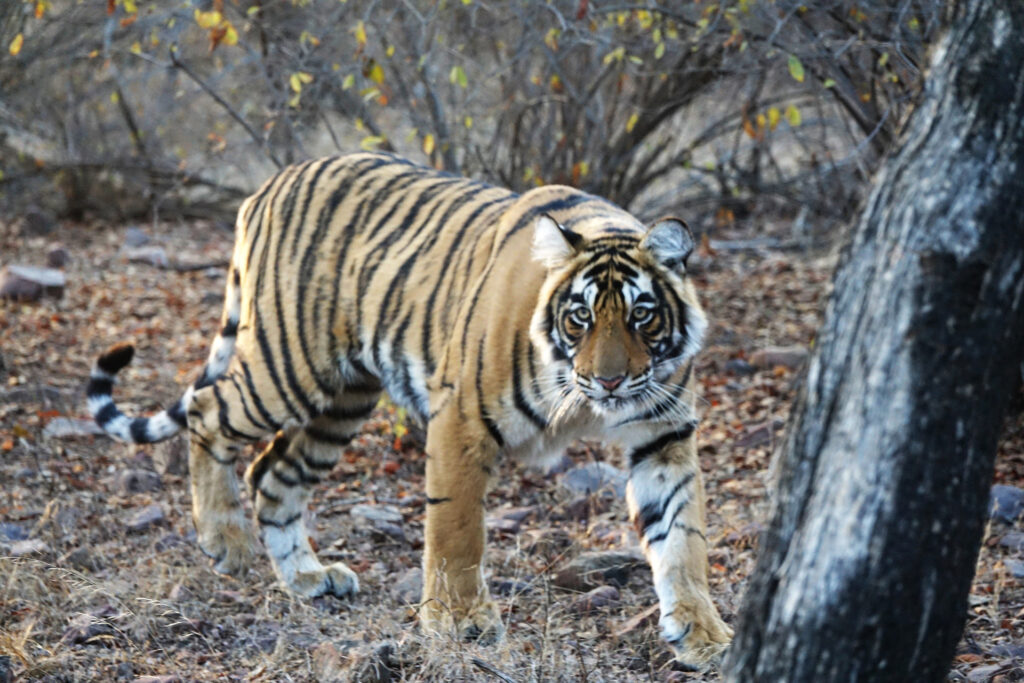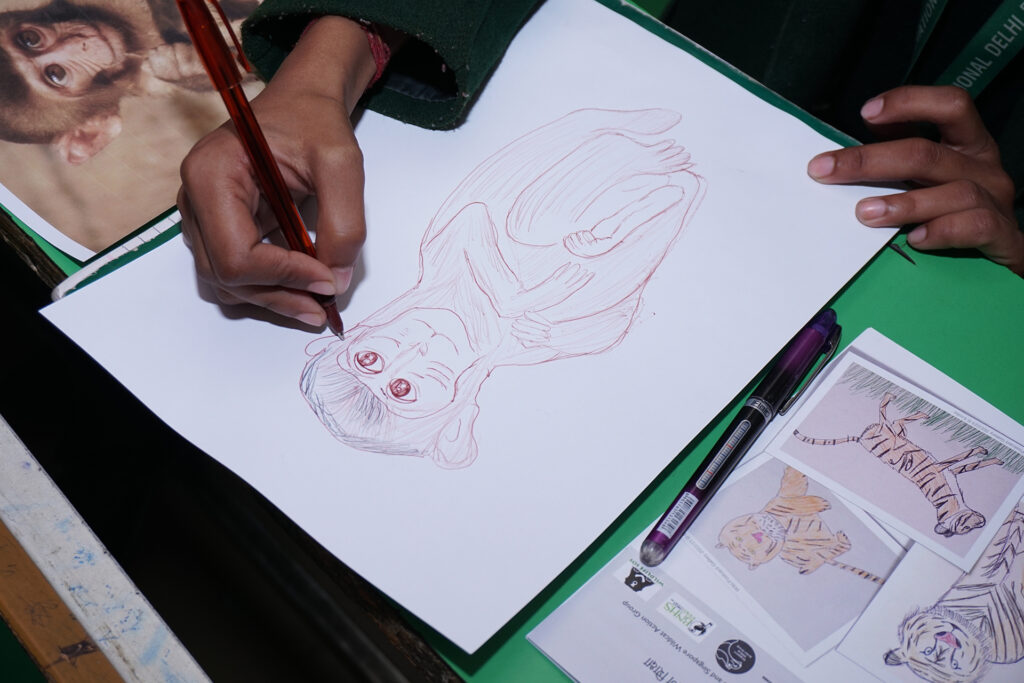Youth Ambassador Ayan champions tigers in India
Born Free’s Youth Ambassador Ayan Mehra has been leading school workshops in India to spread the message of wildlife conservation through art.

Ayan delivering a workshop at the International Delhi Public School
Ayan Mehra has been a passionate advocate for wildlife conservation from the age of 11, and has represented Born Free as a Youth Ambassador since he was 13 years old. Now, aged 17, Ayan is sharing his love of tigers – and his talent for art – by helping to lead school workshops in India with our amazing partners at Drawing for the Planet.

Ayan Mehra
The Importance of Youth as Ambassadors for Wildlife
Although I was born and live in Singapore, I am originally from India. I visit India frequently, but that trip in 2017, was the first time I appreciated the land for its wildlife. In fact, I had always thought of India as crowded with people, bustling with energy, warm with great food and conversations; but never as a place for wildlife to thrive, as there were just too many humans!
This couldn’t be further from the truth, and it made me realise, that spreading awareness of our rich heritage among India’s children, is the first step to creating a generation who will appreciate, protect and support wildlife.
The Tiger’s Forest – Delhi Edition
So, in January this year, I had the privilege of bringing The Tiger’s Forest (TTF) workshop to elementary and middle school students at the International Delhi Public School (IDPS) and the Amar Public School.
The Tiger’s Forest is a project initiated by Drawing for the Planet working in partnership with Born Free Foundation, Wildlife SOS and savewildlife.art. I am very fortunate to be the Project Ambassador for the initiative, and help spread the message of wildlife conservation through art. The Tiger’s Forest celebrates not just tigers, but all the beautiful animals that live in their ecosystem.
Why Are Tigers Endangered?

A tiger in Ranthambore (c) Ayan Kamath Mehra
The first part of the Tiger’s Forest workshop led by Born Free or its partners, is about tigers, their habitats, and why their survival is threatened. Workbooks are handed out to students so that they can follow along with the lesson, and really engage with the complex reasons behind habitat loss, human-wildlife conflict, and poaching.
For the Delhi workshops, Aishwarya Reddy Ravugari from Wildlife SOS led this section. She is an amazing wildlife teacher and inspired the kids to and ask and answer many questions. It struck me how interested many of the kids were in the idea of conservation, as I would think that living in the densely urban heart of Gurugram, wildlife wouldn’t be top of mind. I distinctly remember one child asking the question, “What does rehabilitation mean? Can’t we just release the animals back into the wild?”
This is a really interesting question, as the answer is complex and involves teaching people about how wildlife can only thrive in the wild if the conditions are right and they develop natural survival instincts suited to their environment. It also provokes a conversation on when and what kinds of captivity are acceptable, as rehabilitation often involved stints of semi-captivity for rescued animals in enclosures simulating their actual wild habitats.
From Passion to Action
After the tiger conservation lesson, I would take over the workshop and share my story – about getting involved as an 11-year-old 6th-grader. I talked about my second trip to Africa in 2019, when I didn’t see any rhinos, and how that ignited my quest to help wildlife. I explained how at the time, rhinos were my favourite animal, as their majestic horns, wise eyes, and bulletproof skin made them the coolest battle tanks of the savannah.
It was a book my Mom bought me, by conservationist Lawrence Anthony from Thula Thula, that explained how rhinos were being brutally poached for their horns. This broke my heart and inspired me to do something about it. Despite being just 11 years old, and a student like them, I wanted to make a difference.
I didn’t know how to start back then, but I told the kids about how I reached out to many wildlife charities, and what they all told me to do was to raise awareness among my friends. While this was a good start, I felt I had to do more, so I combined my passions of art and wildlife to sell my drawings and raise funds for wildlife conservation that way. While first it was just family and friends buying my artwork, slowly, my project snowballed, and I was selling more and more to people I didn’t even know. I also started working with charities, such as Wildlife SOS, ACRES in Singapore, and I became a Born Free Youth Ambassador.
Drawing for Wildlife Conservation

(C) Wildlife SOS
Finally, I moved onto the last section (and most fun section) of the workshop. This was the practical Biro wildlife drawing workshop, where with the ballpoint pens we provided, students would create magnificent drawing of the animals that inhabit the Tiger’s forest.
Normally, this section would be led by Jane Lee McCracken, the founder of Drawing for the Planet, but she unfortunately couldn’t make this round of workshops in person. Instead, I quickly went over the instruction on how to make biro drawings, which are drawing with ball point pens and no opportunity to erase any lines!
It was interesting to see the differences between children in how they approached art. While some of them immediately started drawing, others were hesitant, their eyes darting from the reference to their blank paper. As an artist, I relate to this feeling. It is harder to start than to keep going. So, I sat with these students and helped them get started on their outline. And suddenly it was like a switch had flipped, and the drawing almost drew itself as hands flew over paper and intricate rhinos, birds, snakes, monkeys and tigers started to appear. The joy of seeing the biro pens snatched out of my hand, as these artists hit their ‘flow’, was incredible.
After everyone had themselves and their artwork pictured by Wildlife SOS’s photographer, there was a feedback form from Drawing for the Planet that the children could fill out. It was really cool to see that many of the kids reflected not only on their drawings, but on their thoughts about the importance of wildlife conservation in India.
I left New Delhi feeling especially lucky to have been a part of the Tiger’s Forest workshop at two special schools with incredibly talented and passionate artists. I look forward to the next chapters of The Tiger’s Forest in India, Singapore and around the world.

Ayan with a final mural of students’ drawings from previous workshops in Singapore (c) Wildlife SOS
This blog has been reproduced with permission from savewildlife.art.
